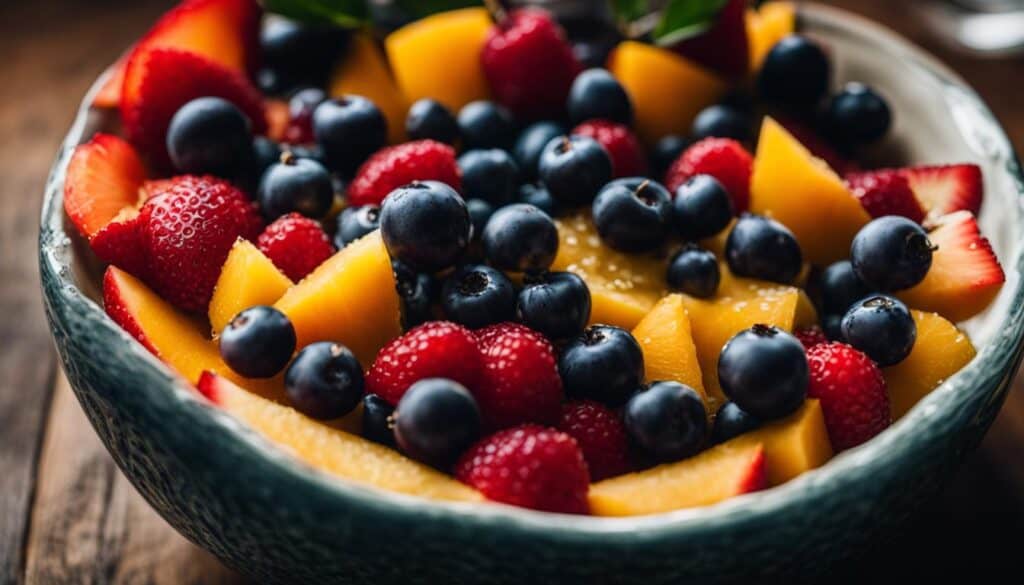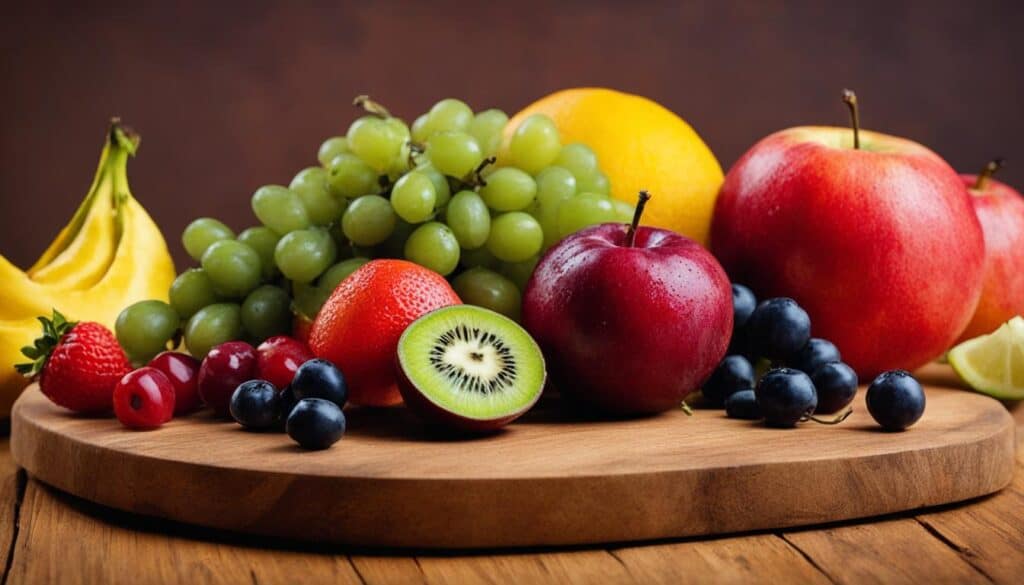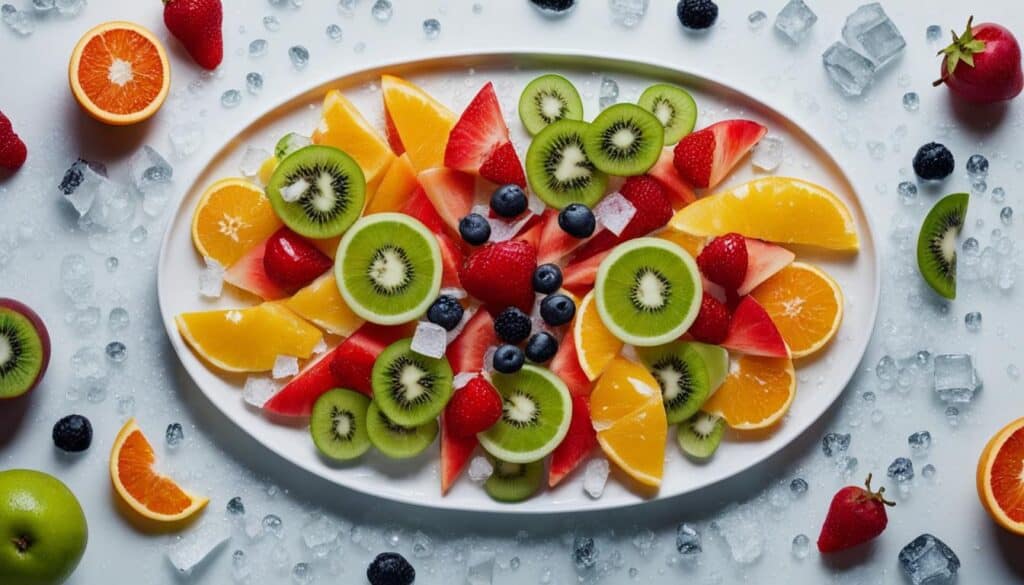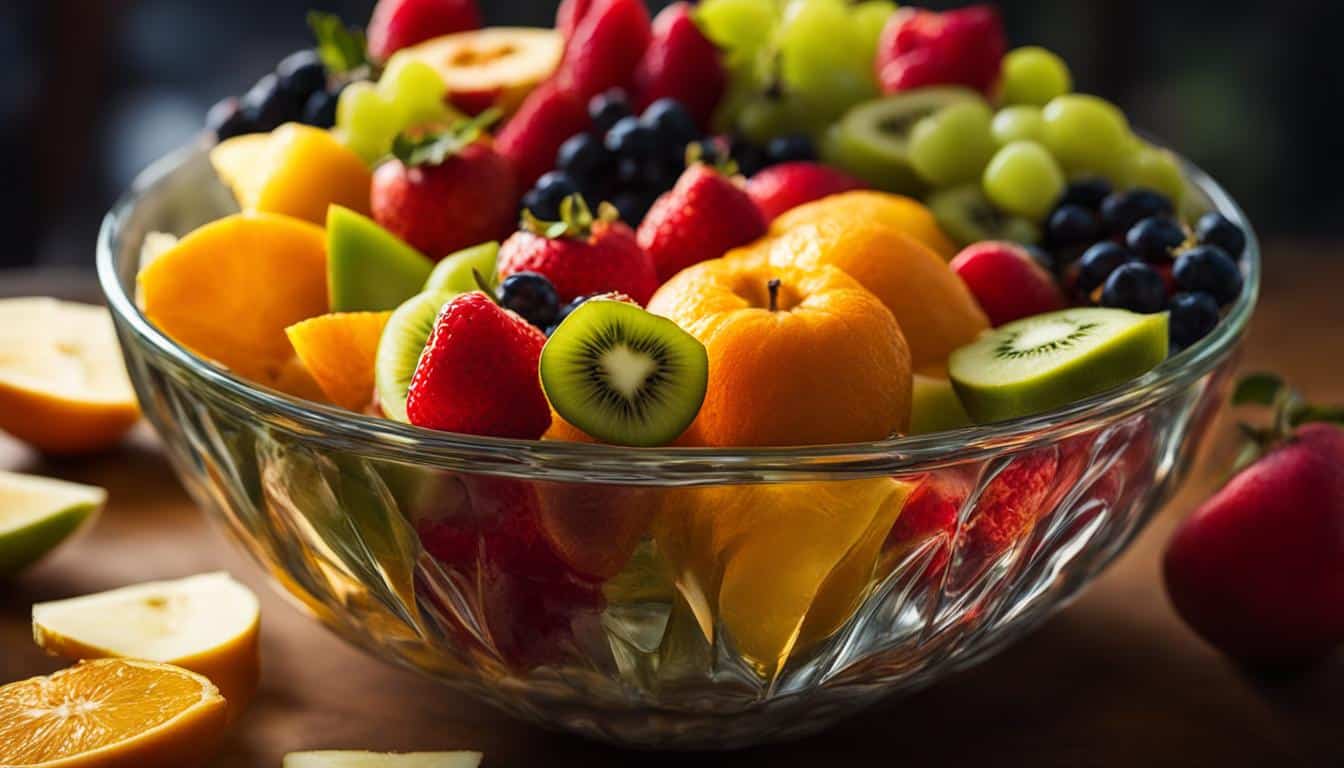Have you ever wondered if cut fruit can still ripen? It’s a common question among fruit enthusiasts, and the answer is not always straightforward. The ability of fruit to ripen after being cut depends on several factors, including the type of fruit and its ripening process.
In this article, we will explore the fascinating world of fruit ripening and provide you with tips on how to ripen cut fruit effectively. Whether you’re a fruit lover or a curious chef, understanding this process can help you maximize the flavor and freshness of your favorite fruits.
Key Takeaways:
- Not all fruits can ripen after being cut. Some fruits are climacteric and can continue to ripen after being picked, while others are non-climacteric and do not ripen further.
- Fruits that can ripen after being cut include apples, bananas, pears, and plums. These fruits can be ripened by placing them in a paper bag with a ripe apple or banana, as these fruits release ethylene gas, which speeds up the ripening process.
- Non-climacteric fruits, such as berries and citrus fruits, do not ripen further once they are removed from the plant. It is best to purchase these fruits ripe and store them properly to maintain their freshness.
- To ripen cut fruit naturally, it is recommended to keep it at room temperature and store it in a ripening bowl or loosely closed brown paper bag.
- Proper storage and handling of cut fruit are essential for preserving its freshness. Refrigerate or freeze cut fruits in covered containers, and avoid leaving them at room temperature for more than two hours.
Understanding Fruit Ripening Process
Fruit ripening is a fascinating natural process that occurs when fruit reaches a specific stage of maturity. This process, however, can only take place while the fruit is still attached to the plant.
There are two main categories of fruits when it comes to ripening: climacteric fruits and non-climacteric fruits. Climacteric fruits are capable of ripening on the plant and can continue to ripen even after they have been picked. On the other hand, non-climacteric fruits do not ripen any further once they are removed from the plant.
Understanding the distinction between these two categories is crucial in order to properly ripen cut fruit. By knowing which fruits fall into each category, you can determine the best methods for ripening cut fruit naturally and maximizing its flavor.
Let’s take a closer look at the ripening process of both climacteric and non-climacteric fruits:
| Climacteric Fruits | Non-Climacteric Fruits |
|---|---|
| Apples | Berries |
| Apricots | Cherries |
| Bananas | Citrus fruits |
| Cantaloupes | Grapes |
| Kiwis | Pineapples |
| Mangoes | Pomegranates |
| Pears | Raspberries |
| Plums | Strawberries |
| Watermelons |
Fruits That Can Ripen After Picking
Certain fruits have the ability to ripen after being cut. These include apples, apricots, bananas, cantaloupes, kiwis, mangoes, pears, and plums. To ripen these fruits, they can be placed in a paper bag with a ripe banana or apple, as these fruits release ethylene gas which speeds up the ripening process. It is also important to store these fruits at room temperature until they reach the desired level of ripeness.
| Fruit | Ripening Tips |
|---|---|
| Apples | Place in a paper bag with a ripe banana or apple. |
| Apricots | Store at room temperature until ripe. |
| Bananas | Allow to ripen at room temperature. |
| Cantaloupes | Store at room temperature until ripe. |
| Kiwis | Place in a paper bag with a ripe banana or apple. |
| Mangoes | Store at room temperature until ripe. |
| Pears | Place in a paper bag with a ripe banana or apple. |
| Plums | Store at room temperature until ripe. |
By following these tips, you can effectively ripen cut fruit and enjoy its delicious flavors. Remember to monitor the fruits daily and remove any spoiled ones to maintain the freshness of the batch.
Techniques for Ripening Sliced Fruit

In order to preserve the freshness of cut fruit, it is important to know the techniques for ripening sliced fruit. By following these methods, you can ensure that your fruit reaches its optimal ripeness while maintaining its delicious flavor. Here are some effective techniques:
1. Keep at Room Temperature
When ripening sliced fruit, it is best to keep them at room temperature. This allows the natural ripening process to take place. Avoid placing the fruits in the refrigerator as it can slow down the ripening process.
2. Use a Ripening Bowl or Brown Paper Bag
To speed up the ripening process, you can place the sliced fruits in a ripening bowl or a loosely closed brown paper bag. This helps to trap the ethylene gas released by the fruits, which accelerates the ripening. Remember to keep the fruits spread apart and avoid overcrowding to allow for proper air circulation.
3. Utilize Ripe Bananas
Ripe bananas can be a great tool for ripening other fruits. Place a ripe banana alongside the sliced fruit in a bag or ripening bowl. Bananas release a higher amount of ethylene gas compared to other fruits, which can help in ripening the surrounding fruits at a faster rate.
4. Daily Fruit Check
It is important to check the ripening progress of your sliced fruit daily. Inspect each fruit for any signs of spoilage or overripeness. Remove any spoiled fruits immediately to prevent them from affecting the freshness of the other fruits.
By following these techniques for ripening sliced fruit, you can ensure that your cut fruit remains fresh and flavorful. Enjoy the ripe and juicy rewards of your patience and careful attention!
Fruits That Do Not Ripen After Picking

Not all fruits have the ability to ripen after being cut. These include berries, cherries, citrus fruits, grapes, pineapples, pomegranates, raspberries, strawberries, and watermelons. These fruits should be purchased ripe and stored in the refrigerator to maintain their quality. It is important to note that these fruits may soften after picking, but their flavor will not improve.
| Fruits That Do Not Ripen After Picking |
|---|
| Berries |
| Cherries |
| Citrus fruits |
| Grapes |
| Pineapples |
| Pomegranates |
| Raspberries |
| Strawberries |
| Watermelons |
Tips for Preserving Cut Fruit Freshness

To preserve the freshness of cut fruit, it is important to store it properly. By following these simple tips, you can ensure that your cut fruit stays delicious and fresh for longer.
1. Refrigerate in Covered Containers
After cutting your fruits, transfer them to covered containers and refrigerate them. This helps to maintain their freshness and prevents the growth of bacteria. Choose containers that are airtight to keep the fruits from drying out.
2. Freeze in Plastic Freezer Containers
If you have excess cut fruit that you won’t be able to consume within a few days, consider freezing it. Place the cut fruit in plastic freezer containers, making sure to leave enough space for expansion. Freezing preserves the freshness of the fruit and allows you to enjoy it later.
3. Avoid Leaving at Room Temperature
It is important to avoid leaving cut fruit at room temperature for more than two hours. This is because bacteria can multiply rapidly in warm environments, leading to spoilage. If you’re serving cut fruit at a party or gathering, make sure to place it on ice or in a cool area to keep it fresh.
4. Use within a Few Days
While cut fruit can be stored for a short period of time, it’s best to consume it within a few days for optimal freshness and flavor. As time passes, the texture and taste of the fruit may start to deteriorate, so try to enjoy it as soon as possible.
Proper storage is key to preserving the freshness of cut fruit. By refrigerating or freezing your cut fruit and avoiding prolonged exposure to room temperature, you can savor the best quality and flavor of your favorite fruits.
Knowing When Fruit is Ripe
When it comes to enjoying the optimal sweetness and flavor of fruit, knowing when it is ripe is key. The fruit ripening process begins when the fruit reaches physiological maturity, meaning it has reached its full size and internal development. However, it is important to note that ripeness is not solely determined by size or color but by the fruit’s taste, texture, and aroma.
Several factors influence the ripening process, including temperature and humidity. Higher temperatures can accelerate the ripening process, while cooler temperatures can slow it down. Humidity also plays a role, with higher humidity levels helping to prevent the fruit from drying out and losing its moisture content.
Understanding the stages of fruit maturity can assist in determining when the fruit is ripe and ready to be consumed. These stages typically include the following:
- Mature Green: The fruit is fully developed but not yet ripe. It is firm, lacks sweetness, and may have a bitter taste.
- Breaker: The fruit may exhibit slight softening or color change. It is approaching ripeness but may still lack full flavor.
- Turning: The fruit’s color is starting to change, and it becomes more aromatic. Its flavor is developing, but it may still be slightly acidic.
- Ripe: The fruit is fully colored, fragrant, and has reached its peak flavor. It is tender, juicy, and sweet.
- Overripe: The fruit is beyond its optimal ripeness. It may be soft, mushy, and have an overly sweet or fermented taste.
By observing and experiencing these stages, you can determine the best time to harvest or purchase fruit for maximum flavor and enjoyment.
| Fruit Stage | Characteristics |
|---|---|
| Mature Green | Firm texture, lacks sweetness |
| Breaker | Slight softening, minor color change |
| Turning | Color change, increased aroma |
| Ripe | Full color, fragrant, peak flavor |
| Overripe | Soft, mushy, overly sweet or fermented taste |
Remember, not all fruits have the ability to ripen after being cut, so it is important to choose the right fruits and harvest or purchase them at the appropriate stage of maturity for optimal enjoyment.
Conclusion
In conclusion, understanding how to ripen fruit after cutting and preserve its freshness is essential for maximizing flavor and enjoyment. While certain fruits like apples, bananas, and pears have the ability to ripen after picking, others such as berries, cherries, and citrus fruits do not. By following the recommended techniques and storing cut fruit properly, you can ensure that it remains fresh and delicious.
Proper storage and handling are key to preserving the freshness of cut fruit. Refrigerate cut fruits in covered containers or freeze them in plastic freezer containers to maintain their quality. It is important to avoid leaving cut fruit at room temperature for more than two hours to prevent bacteria growth.
When it comes to ripening cut fruit, climacteric fruits like apples and mangoes can be accelerated by placing them in a paper bag with a ripe banana or apple. These fruits release ethylene gas, which speeds up the ripening process. Non-climacteric fruits like berries and citrus fruits, on the other hand, do not ripen further once they are removed from the plant.
By understanding the ripening process and following the recommended techniques, you can enjoy perfectly ripe flavors even with cut fruit. Whether you’re making a fruit salad, a smoothie, or a delicious dessert, ensuring the freshness and ripeness of cut fruit will elevate your culinary creations.
Resources
If you’re looking for more information on preserving cut fruit freshness and techniques for ripening sliced fruit, here are some valuable resources you can refer to:
- Produce for Better Health Foundation – How do I select fresh fruit at the grocery store?
- United States Department of Agriculture (USDA) – How should I store cut fruits and vegetables?
- Empress of Dirt – Fruits That Ripen After Picking & Those That Do Not (Free Tipsheet)
FAQ
Can cut fruit still ripen?
Yes, some fruits can ripen even after being cut, while others cannot. Understanding which fruits can ripen after cutting is important for maximizing flavor and freshness.
How can I ripen fruit after cutting?
To ripen cut fruits like apples, apricots, bananas, cantaloupes, kiwis, mangoes, pears, and plums, you can place them in a paper bag with a ripe banana or apple. These fruits release ethylene gas, which speeds up the ripening process. Storing cut fruits at room temperature also helps in ripening them.
Does cut fruit ripen?
Yes, cut fruits can ripen if they belong to the category of fruits that can ripen after being cut. However, certain fruits like berries, cherries, citrus fruits, grapes, pineapple, pomegranates, raspberries, strawberries, and watermelons do not ripen further once they are removed from the plant.
What are some tips for ripening cut fruit?
To naturally ripen sliced fruits, keep them at room temperature. Placing them in a ripening bowl or loosely closed brown paper bag can help speed up the ripening process. It is recommended to keep the fruits spread apart and not touching each other. Ripe bananas can also be used to accelerate the ripening of other fruits by placing them in a bag together. Check the fruits daily and remove any spoiled ones to ensure freshness.
How can I preserve the freshness of cut fruit?
To preserve the freshness of cut fruit, it is important to store it properly. Cut fruits should be refrigerated in covered containers or frozen in plastic freezer containers. Avoid leaving cut fruit at room temperature for more than two hours to prevent bacteria growth.
How can I know when fruit is ripe?
The ripening process starts when the fruit reaches physiological maturity. Factors like temperature and humidity play a role in ripening. Understanding the stages of fruit maturity, from mature to ripe, can help in determining the best time to harvest or purchase fruit.
Where can I find more information and resources on preserving the freshness of cut fruit and techniques for ripening sliced fruit?
You can refer to the Produce for Better Health Foundation, United States Department of Agriculture (USDA), and Empress of Dirt for more information and resources on preserving the freshness of cut fruit and techniques for ripening sliced fruit.





Leave a Reply